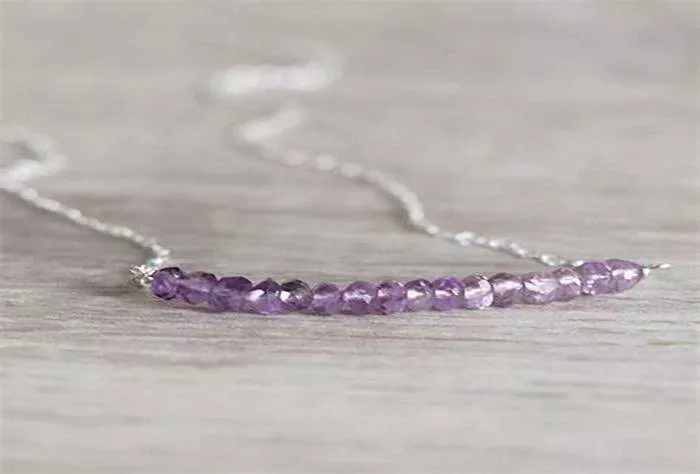Amethyst, as the birthstone for February, is highly favored for its deep purple color and spiritual implications. However, with the advancement of synthetic gemstone technology, the market is flooded with a large number of artificial amethyst jewelry with realistic appearances.
Core Differences between natural Amethyst and synthetic Products
Formation process and components
Natural amethyst is born in volcanic or sedimentary rocks and needs to endure high-temperature and high-pressure environments for millions of years. Its purple color is derived from the trace doping of iron (Fe³⁺) in the quartz crystal structure and the long-term effect of natural radiation. Synthetic amethysts are mostly produced rapidly in the laboratory by the Hydrothermal Method or Flame Fusion. Although both are composed of silicon dioxide (SiO₂), the trace elements and growing conditions are completely different.
Comparison of physical properties
Natural amethyst, synthetic amethyst
The color distribution is uneven. It can be seen that the color bands or patches are highly uniform, and the color is saturated without any gradient
Inclusions: Natural mineral inclusions (such as hematite, rutile), bubbles or arc-shaped growth lines (hydrothermal method characteristics)
Ultraviolet fluorescence is so weak that no reaction may occur, and blue-white fluorescence may appear (due to additives).
The birefringence phenomenon is obvious, and it can be seen that the “double image” effect is usually weak or absent
Professional-level Identification methods
Microscopic observation: Revealing the code of the inner world
Use a 10x magnifying glass or gemstone microscope, and focus on the following features:
Inclusion types: Natural amethyst often contains “tiger-striped” liquid inclusions, needle-like rutile or feather-like fissures. The finished products may show fine bubble clusters or parallel arranged “breadcrumb” -like residues (traces of hydrothermal growth).
Color zoning: The purple color of natural amethyst often appears in “patches” or is distributed along the crystal growth axis, while the color of synthetic products is uniform to nearly perfect.
Case: A necklace claiming to be “natural amethyst” was found to have a large number of regularly arranged bubbles under a microscope and was eventually identified as a fused synthetic product.
Optical instrument inspection
Polariscope
Natural amethyst, as a variety of quartz, has typical heterogeneous characteristics. When the gemstone is rotated, alternating light and dark changes can be seen. If the synthetic product contains excessive glassy components, abnormal interference patterns may be displayed.
Spectroscope:
Natural amethyst has a wide absorption band at 550nm (a characteristic of iron coloration), while some synthetic products may show abnormal absorption lines due to the addition of cobalt.
Professional laboratory testing (if unable to make a judgment by oneself)
Infrared spectroscopy (FTIR) : Analyzing the absorption peak of hydroxyl (-OH), natural amethyst is usually more significant than synthetic products as it forms in a water-containing fluid environment.
Raman spectroscopy: It can identify the type of inclusions and minerals. For instance, if artificial rutile, which is common in synthetic environments, is detected, it can be determined that it is not natural.
Daily Practical identification Techniques
Visual observation method
Abnormal color: Synthetic amethyst often presents an “electric purple” or overly deep tones (over-dyed to cover up flaws), while natural products are mostly soft blue-purple or purplish red.
Ice crack test: When the necklace is placed under strong light, fine “rainbow effect” cracks (healing lines) may appear inside the natural amethyst, while the synthetic products are mostly flawless.
Simple physics test
Hardness test (Operate with caution!) :
Amethyst has a Mohs hardness of 7 and can be easily scratched with a steel knife (with a hardness of 5.5) without leaving any marks. However, if the synthetic product is mixed with glass (with a hardness of 5-6), it is prone to being scratched.
Thermal conductivity
Natural amethyst feels cold and dissipates heat slowly, while glass imitations heat up rapidly.
Certificates and brand traceability
Authoritative certificates: GIA, IGI or NGTC certificates are required. Special attention should be paid to the words “Natural Amethyst” and the description of synthetic signs in the annotation column.
Brand ethics: Select designer brands with open supply chains, such as independent studios that promise to use “unoptimized natural mineral label amethyst”.
Ethical Responsibilities of Designers and Design Suggestions
Transparent material declaration
Clearly mark “natural amethyst” or “laboratory-synthesized amethyst” in the product description, and avoid using vague terms such as “true amethyst”. For example: “18K gold set with natural Brazilian amethyst (with IGI certificate).”
The design is adapted to the natural characteristics
Inclusions aesthetics: Design natural amethyst with rutile inclusions as a “starry sky theme” pendant to magnify the artistic value of natural flaws.
Cutting optimization: For the common color band distribution of natural amethyst, trapezoidal cutting (Step Cut) is adopted to enhance the color layering.
Consumer education
During the sales process, offer a “gemstone mini-class”, such as a complimentary card stating: “Your amethyst was born in a volcanic rock fissure 100 million years ago, and the tiny rutile inside is proof of its natural identity.”
Conclusion
Identifying the authenticity of amethyst is a dual exploration of science and aesthetics. For jewelry designers, this not only requires mastering professional instruments and observation skills, but also adhering to the professional ethics of material transparency. The value of natural amethyst lies in its unique growth mark – every color band and every incline is a frozen poem of the Earth’s history. The finished products, on the other hand, allow more people to enjoy the beauty of purple at an affordable price. Whether choosing natural or synthetic designs, sincere designs are always the most precious “gems”.
Related topics:
Does Amethyst Fade in the Sun? A Detailed Insight
The Spiritual Power of Amethyst: Healing and Protection
Is Pink Amethyst Rare? Exploring the Rarity of this Gemstone


